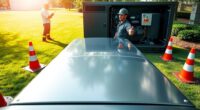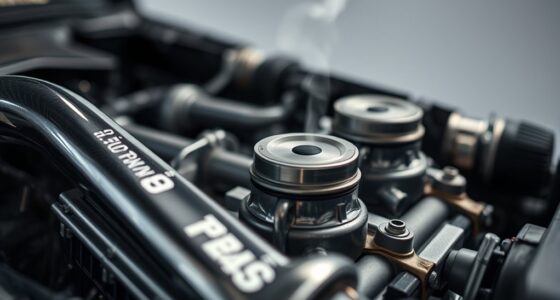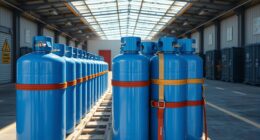If your engine surges at idle, stay calm and take safe actions like easing off the gas and maintaining smooth control. Common causes include fuel system issues, vacuum leaks, or dirty sensors. Watch for warning signs like rough idling, engine noises, or warning lights. Taking preventive steps—regular maintenance and inspections—can reduce risks. If surging persists or warning lights appear, seek professional help. Continued care helps keep you safe and your vehicle running smoothly—learn more below.
Key Takeaways
- Recognize warning signs like unstable RPMs, rough idling, and dashboard lights to ensure timely safety response.
- Ease off the gas and maintain smooth throttle control during surging to prevent loss of vehicle control.
- Regularly inspect and clean fuel system components, including filters and injectors, to reduce surging risk.
- Avoid sudden acceleration or braking if engine surging occurs to maintain vehicle stability and safety.
- Seek professional diagnosis if surging persists or warning lights appear to prevent further engine damage.
Common Causes of Engine Surging at Idle
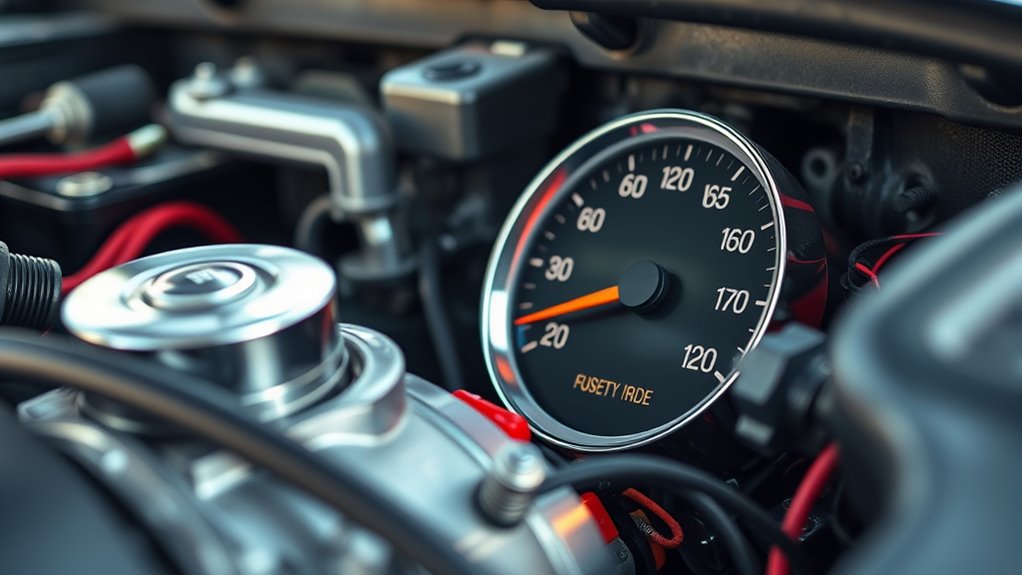
Engine surging at idle often results from issues with the engine’s air intake or fuel delivery systems. One common cause is idle fluctuation, which can happen when the fuel system isn’t providing a steady flow of fuel. Problems like a clogged fuel filter, a malfunctioning fuel pump, or dirty fuel injectors can disrupt fuel delivery, causing the engine to surge or fluctuate in RPM. Additionally, a vacuum leak in the intake manifold or a dirty throttle body can upset the airflow, leading to unstable idling. These issues interfere with the precise balance of air and fuel the engine needs to run smoothly. Addressing these problems promptly helps restore stable idle speed and prevents further engine performance issues.
Recognizing Warning Signs and Symptoms

When your vehicle’s idle becomes irregular or unstable, it’s a clear sign that something isn’t right with the engine’s fueling or airflow. Recognizing warning indicators early can prevent further damage. Look out for idle instability, such as surging, stalling, or uneven RPMs. You might notice the engine revving higher or lower without your input. Other warning signs include rough idling, unusual noises, or a noticeable decrease in performance. If your dashboard shows warning lights, like the check engine light, it’s a sign to investigate further. Ignoring these symptoms can lead to more severe problems down the line. Paying attention to these warning signs helps you identify potential issues early, keeping your engine running smoothly and safely. Additionally, understanding engine performance issues can help you troubleshoot and maintain your vehicle more effectively.
Immediate Steps to Take When Surging Occurs

If your vehicle begins surging at idle, the first step is to stay calm and avoid sudden acceleration or braking. Focus on maintaining smooth throttle response to preserve idle stability. Gently ease off the gas pedal if you notice surging, avoiding abrupt movements that could worsen the issue. Recognize that engine control plays a crucial role in preventing surging and maintaining smooth operation.
Preventative Maintenance to Avoid Surging Issues

Regular preventative maintenance can substantially reduce the likelihood of surging at idle. Start by regularly inspecting your fuel system to guarantee there are no clogs or leaks that could disrupt fuel flow. Keeping the fuel filter clean helps maintain proper fuel delivery, preventing erratic engine behavior. Sensor diagnostics are equally crucial; sensors like the idle air control or mass airflow sensor should be tested and calibrated regularly to ensure accurate readings. Faulty sensors can send incorrect data to your engine’s computer, causing surging. Additionally, clean or replace air filters to secure optimal airflow. Vetted – Halloween Product Reviews Regular maintenance of these components keeps your engine running smoothly, reduces surging issues, and extends the lifespan of your vehicle. Consistent checkups are a simple step toward safer, more reliable operation.
When to Seek Professional Assistance
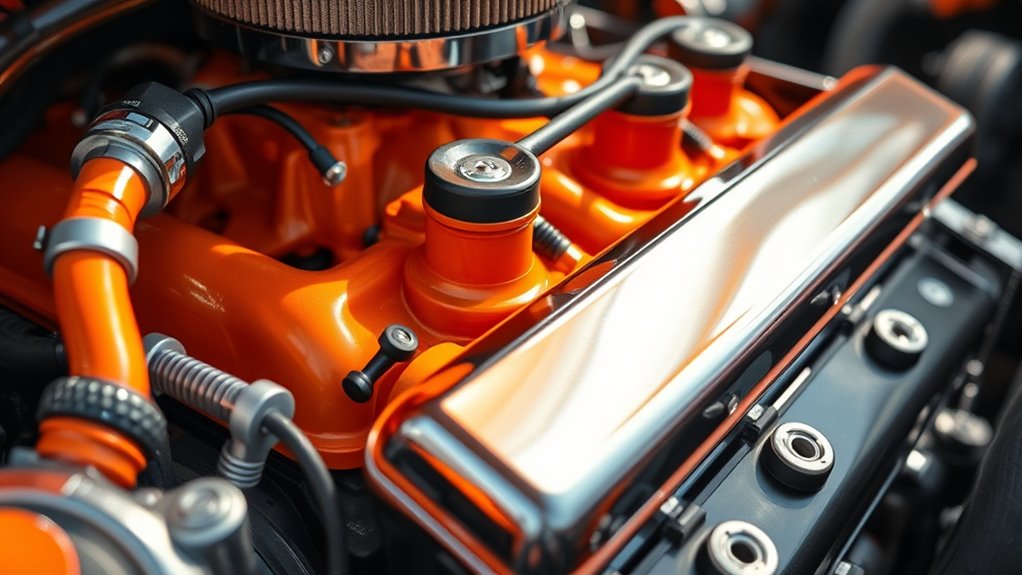
Recognizing the signs that indicate a need for professional help can save you time and prevent further engine damage. If your engine surges at idle despite basic troubleshooting, it’s time to consult a mechanic. They use diagnostic tools to accurately identify the root cause of the problem, which might be complex sensor issues or fuel system faults. Attempting repair procedures beyond your skill level can worsen the situation or cause costly damage. Seek professional assistance if surging persists after cleaning or basic adjustments, or if warning lights appear. A qualified technician can perform thorough diagnostics and handle repair procedures efficiently. Additionally, issues related to sensor calibration can be particularly challenging to resolve without specialized equipment. Don’t ignore persistent surging—getting expert help ensures your engine is properly repaired and prevents future problems.
Frequently Asked Questions
Can Engine Surging at Idle Damage My Vehicle Long-Term?
Yes, engine surging at idle can damage your vehicle long-term. It often indicates issues like a faulty fuel system or sensor malfunctions, which can cause inconsistent engine performance. Over time, these problems may lead to increased wear on engine components, reduced fuel efficiency, and potential breakdowns. Addressing surging early by checking your fuel system and sensors helps prevent long-term damage and keeps your vehicle running smoothly.
Are Hybrid or Electric Vehicles Susceptible to Engine Surging Issues?
You might think hybrid or electric vehicles are invincible, but they can still face engine surges. Hybrid systems sometimes experience surges due to faulty sensors or control issues, and electric motor issues can cause unexpected power fluctuations. While less common than in traditional engines, these surges can still happen, so staying alert and maintaining your vehicle guarantees you avoid surprises that could lead to long-term damage.
How Does Weather Impact Engine Surging at Idle?
Weather impacts engine surging at idle by affecting altitude and humidity. Higher altitudes reduce air density, causing your engine to struggle with proper air-fuel mixture, which can lead to surging. Increased humidity impacts combustion efficiency, potentially worsening idle stability. You might notice surging more often in humid conditions or when traveling to higher elevations. To minimize issues, guarantee your vehicle’s idle settings are properly calibrated for your environment and keep up with regular maintenance.
Is It Safe to Drive With a Surging Engine?
It’s not safe to drive with a surging engine because it could indicate a fuel system issue or sensor malfunction that affects your vehicle’s performance. Surging can cause unpredictable acceleration and loss of control. You should have a mechanic inspect your car promptly to diagnose and fix the problem. Continuing to drive could lead to further damage or safety risks, so don’t ignore the warning signs.
Can Aftermarket Modifications Cause Idle Surging Problems?
Yes, aftermarket parts can cause idle surging problems. When you install aftermarket parts, they might not perfectly match your engine’s original specifications, disrupting engine performance. This mismatch can lead to issues like irregular air-fuel mixture or faulty sensors, which cause the engine to surge at idle. Always verify that the aftermarket modifications are compatible with your vehicle and properly installed to prevent idle surging problems.
Conclusion
By understanding the causes and signs of engine surging at idle, you can take proactive steps to keep your vehicle running smoothly. Regular maintenance and prompt attention to warning signs are essential, but when should you call in a professional? Remember, neglecting these issues could lead to more costly repairs down the line—so isn’t prevention always the smarter choice? Stay vigilant, and your engine will thank you.

